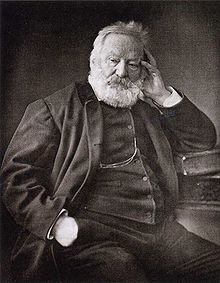The Statue of Victor Hugo
The Statue of Victor Hugo – wiersz angielskiego poety i dramaturga Algernona Charlesa Swinburne’a[1][2], opublikowany w 1882 w wydanym w Londynie nakładem wydawnictwa Chatto & Windus tomie Tristram of Lyonesse and Other Poems.





Forma
edytujUtwór składa się z dwudziestu pięciu numerowanych zwrotek ośmiowersowych. Strofy te realizują model sycyliany, czyli zwrotki rymowanej abababab[3].
- Since in Athens God stood plain for adoration,
- Since the sun beheld his likeness reared in stone.
- Since the bronze or gold of human consecration
- Gave to Greece her guardian's form and feature shown,
- Never hand of sculptor, never heart of nation,
- Found so glorious aim in all these ages flown
- As is theirs who rear for all time's acclamation
- Here the likeness of our mightiest and their own.
Treść
edytujWiersz stanowi hołd Swinburne’a dla francuskiego pisarza, poety i republikanina Wiktora Hugo[4], którego autor podziwiał i którego osobą i twórczością żywo się interesował. Swinburne poświęcił Wiktorowi Hugo także wiersz zatytułowany To Victor Hugo[5]. Wydał też zbiór studiów krytycznoliterackich o jego liryce[6]. Fascynacja Swinburne’a prozą, poezją i dramaturgią Wiktora Hugo datowała się od kiedy w szkole w Eton dostał w nagrodę pięknie zdobione wydanie powieści Katedra Marii Panny w Paryżu z ilustracjami Tony’ego Johannota[7].
Przekład
edytujNa język francuski wiersz Swinburne’a przełożyła poetka pochodzenia rosyjskiego Tola Dorian[8].
- Depuis les jours où Zeus, dans Athènes visible,
- Levait son front d’ivoire et d’or vers le soleil,
- Où la Grèce adorait la splendeur indicible
- Du visage auquel nul visage n’est pareil,
- Jamais forme, bravant le bloc du statuaire,
- Ne s’offrit plus superbe à sa tremblante main ;
- Jamais peuple ne vit, dans aucun sanctuaire,
- Sérénité plus douce en un dieu plus humain[9].
Przypisy
edytuj- ↑ Algernon Charles Swinburne, [w:] Encyclopædia Britannica [dostęp 2017-03-02] (ang.).
- ↑ Algernon Charles Swinburne, Poet (1837–1909). PoetryFoundation.org. [dostęp 2017-03-02]. (ang.).
- ↑ Ottava rima. treccani.it. [dostęp 2017-03-02]. (wł.).
- ↑ Hugo Victor Marie, [w:] Encyklopedia PWN [online], Wydawnictwo Naukowe PWN [dostęp 2017-03-02].
- ↑ Algernon Charles Swinburne: To Victor Hugo. Bartleby.com. [dostęp 2017-03-02]. (ang.).
- ↑ Algernon Charles Swinburne: A Study of Victor Hugo. Archive.org, 1886. [dostęp 2017-03-02]. (ang.).
- ↑ John Andrew Frey: A Victor Hugo Encyclopedia. books.google.pl, 1999. s. 253. [dostęp 2017-03-02]. (ang.).
- ↑ Charlotte Ribeyrol: A channel passage: Swinburne and France, w: Yisrael Levin (red.), A.C. Swinburne and the Singing Word: New Perspectives on the Mature Work. books.google.pl, 109. [dostęp 2017-03-02]. (ang.).
- ↑ Algernon Charles Swinburne: Ode à la statue de Victor Hugo, tłum. Tola Dorian. fr.wikisource.org. [dostęp 2017-03-02]. (fr.).
Bibliografia
edytuj- Algernon Charles Swinburne: Tristram of Lyonesse, and Other Poems. Archive.org, 1882. [dostęp 2017-03-02]. (ang.).
Linki zewnętrzne
edytuj- Algernon Charles Swinburne: The Statue of Victor Hugo. telelib.com. [dostęp 2017-03-02]. (ang.).
- Algernon Charles Swinburne: The Statue of Victor Hugo. poetrycat.com. [dostęp 2017-03-02]. (ang.).